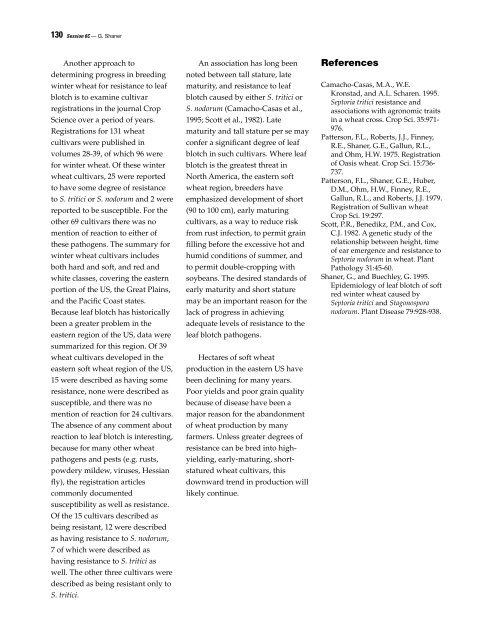Septoria and Stagonospora Diseases of Cereals - CIMMYT ...
Septoria and Stagonospora Diseases of Cereals - CIMMYT ...
Septoria and Stagonospora Diseases of Cereals - CIMMYT ...
You also want an ePaper? Increase the reach of your titles
YUMPU automatically turns print PDFs into web optimized ePapers that Google loves.
Session 6C — G. Shaner<br />
130<br />
Another approach to<br />
determining progress in breeding<br />
winter wheat for resistance to leaf<br />
blotch is to examine cultivar<br />
registrations in the journal Crop<br />
Science over a period <strong>of</strong> years.<br />
Registrations for 131 wheat<br />
cultivars were published in<br />
volumes 28-39, <strong>of</strong> which 96 were<br />
for winter wheat. Of these winter<br />
wheat cultivars, 25 were reported<br />
to have some degree <strong>of</strong> resistance<br />
to S. tritici or S. nodorum <strong>and</strong> 2 were<br />
reported to be susceptible. For the<br />
other 69 cultivars there was no<br />
mention <strong>of</strong> reaction to either <strong>of</strong><br />
these pathogens. The summary for<br />
winter wheat cultivars includes<br />
both hard <strong>and</strong> s<strong>of</strong>t, <strong>and</strong> red <strong>and</strong><br />
white classes, covering the eastern<br />
portion <strong>of</strong> the US, the Great Plains,<br />
<strong>and</strong> the Pacific Coast states.<br />
Because leaf blotch has historically<br />
been a greater problem in the<br />
eastern region <strong>of</strong> the US, data were<br />
summarized for this region. Of 39<br />
wheat cultivars developed in the<br />
eastern s<strong>of</strong>t wheat region <strong>of</strong> the US,<br />
15 were described as having some<br />
resistance, none were described as<br />
susceptible, <strong>and</strong> there was no<br />
mention <strong>of</strong> reaction for 24 cultivars.<br />
The absence <strong>of</strong> any comment about<br />
reaction to leaf blotch is interesting,<br />
because for many other wheat<br />
pathogens <strong>and</strong> pests (e.g. rusts,<br />
powdery mildew, viruses, Hessian<br />
fly), the registration articles<br />
commonly documented<br />
susceptibility as well as resistance.<br />
Of the 15 cultivars described as<br />
being resistant, 12 were described<br />
as having resistance to S. nodorum,<br />
7 <strong>of</strong> which were described as<br />
having resistance to S. tritici as<br />
well. The other three cultivars were<br />
described as being resistant only to<br />
S. tritici.<br />
An association has long been<br />
noted between tall stature, late<br />
maturity, <strong>and</strong> resistance to leaf<br />
blotch caused by either S. tritici or<br />
S. nodorum (Camacho-Casas et al.,<br />
1995; Scott et al., 1982). Late<br />
maturity <strong>and</strong> tall stature per se may<br />
confer a significant degree <strong>of</strong> leaf<br />
blotch in such cultivars. Where leaf<br />
blotch is the greatest threat in<br />
North America, the eastern s<strong>of</strong>t<br />
wheat region, breeders have<br />
emphasized development <strong>of</strong> short<br />
(90 to 100 cm), early maturing<br />
cultivars, as a way to reduce risk<br />
from rust infection, to permit grain<br />
filling before the excessive hot <strong>and</strong><br />
humid conditions <strong>of</strong> summer, <strong>and</strong><br />
to permit double-cropping with<br />
soybeans. The desired st<strong>and</strong>ards <strong>of</strong><br />
early maturity <strong>and</strong> short stature<br />
may be an important reason for the<br />
lack <strong>of</strong> progress in achieving<br />
adequate levels <strong>of</strong> resistance to the<br />
leaf blotch pathogens.<br />
Hectares <strong>of</strong> s<strong>of</strong>t wheat<br />
production in the eastern US have<br />
been declining for many years.<br />
Poor yields <strong>and</strong> poor grain quality<br />
because <strong>of</strong> disease have been a<br />
major reason for the ab<strong>and</strong>onment<br />
<strong>of</strong> wheat production by many<br />
farmers. Unless greater degrees <strong>of</strong><br />
resistance can be bred into highyielding,<br />
early-maturing, shortstatured<br />
wheat cultivars, this<br />
downward trend in production will<br />
likely continue.<br />
References<br />
Camacho-Casas, M.A., W.E.<br />
Kronstad, <strong>and</strong> A.L. Scharen. 1995.<br />
<strong>Septoria</strong> tritici resistance <strong>and</strong><br />
associations with agronomic traits<br />
in a wheat cross. Crop Sci. 35:971-<br />
976.<br />
Patterson, F.L., Roberts, J.J., Finney,<br />
R.E., Shaner, G.E., Gallun, R.L.,<br />
<strong>and</strong> Ohm, H.W. 1975. Registration<br />
<strong>of</strong> Oasis wheat. Crop Sci. 15:736-<br />
737.<br />
Patterson, F.L., Shaner, G.E., Huber,<br />
D.M., Ohm, H.W., Finney, R.E.,<br />
Gallun, R.L., <strong>and</strong> Roberts, J.J. 1979.<br />
Registration <strong>of</strong> Sullivan wheat<br />
Crop Sci. 19:297.<br />
Scott, P.R., Benedikz, P.M., <strong>and</strong> Cox,<br />
C.J. 1982. A genetic study <strong>of</strong> the<br />
relationship between height, time<br />
<strong>of</strong> ear emergence <strong>and</strong> resistance to<br />
<strong>Septoria</strong> nodorum in wheat. Plant<br />
Pathology 31:45-60.<br />
Shaner, G., <strong>and</strong> Buechley, G. 1995.<br />
Epidemiology <strong>of</strong> leaf blotch <strong>of</strong> s<strong>of</strong>t<br />
red winter wheat caused by<br />
<strong>Septoria</strong> tritici <strong>and</strong> <strong>Stagonospora</strong><br />
nodorum. Plant Disease 79:928-938.









